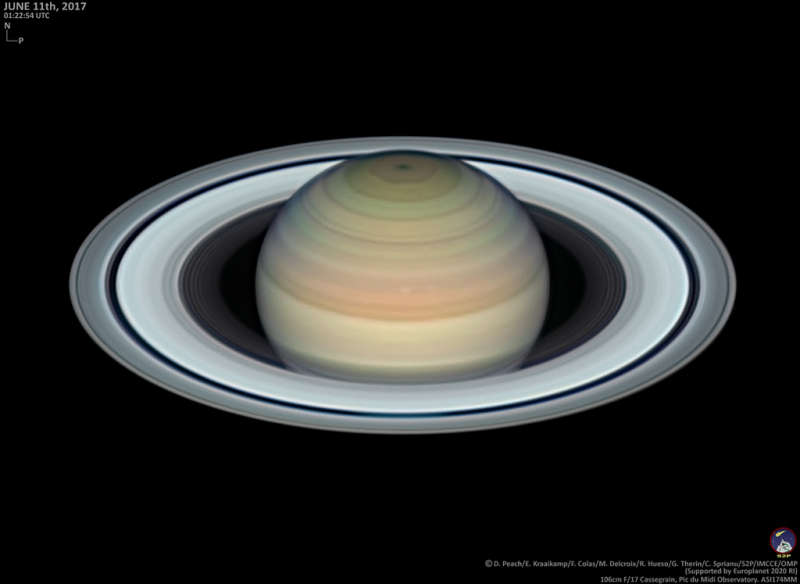Credit & Copyright: D. Peach, E. Kraaikamp, F. Colas, M. Delcroix, R. Hueso, G. Therin,
C. Sprianu, S2P, IMCCE, OMP
Explanation:
Saturn reached its 2017 opposition on June 16.
Of course, opposition means opposite the Sun in Earth's sky and
near opposition Saturn is up all night,
at its closest and brightest for the year.
This remarkably sharp image of the ringed planet was taken only
days before, on June 11,
with a 1-meter telescope from the mountain top
Pic du Midi observatory.
North is at the top with the giant planet's north
polar storm and
curious hexagon
clearly seen bathed in sunlight.
But Saturn's spectacular
ring system
is also shown in stunning detail.
The narrow Encke division is visible around the entire outer A ring,
small ringlets can be traced within the fainter inner C ring, and
Saturn's southern hemisphere can be glimpsed through the wider
Cassini division.
Near opposition Saturn's rings also appear exceptionally bright,
known as the
opposition
surge or Seeliger Effect.
Directly illuminated from Earth's perspective, the ring's icy particles
cast no shadows and strongly backscatter sunlight creating the dramatic
increase in brightness.
Still,
the best views
of the ringed planet are currently
from the Saturn-orbiting Cassini spacecraft.
Diving close,
Cassini's Grand Finale orbit number 9
is in progress.
1999 2000 2001 2002 2003 2004 2005 2006 2007 2008 2009 2010 2011 2012 2013 2014 2015 2016 2017 2018 2019 2020 2021 2022 2023 2024 2025 |
Yanvar' Fevral' Mart Aprel' Mai Iyun' Iyul' Avgust Sentyabr' Oktyabr' Noyabr' Dekabr' |
NASA Web Site Statements, Warnings, and Disclaimers
NASA Official: Jay Norris. Specific rights apply.
A service of: LHEA at NASA / GSFC
& Michigan Tech. U.
|
Publikacii s klyuchevymi slovami:
Saturn - Saturn - protivostoyanie
Publikacii so slovami: Saturn - Saturn - protivostoyanie | |
Sm. takzhe:
Vse publikacii na tu zhe temu >> | |
